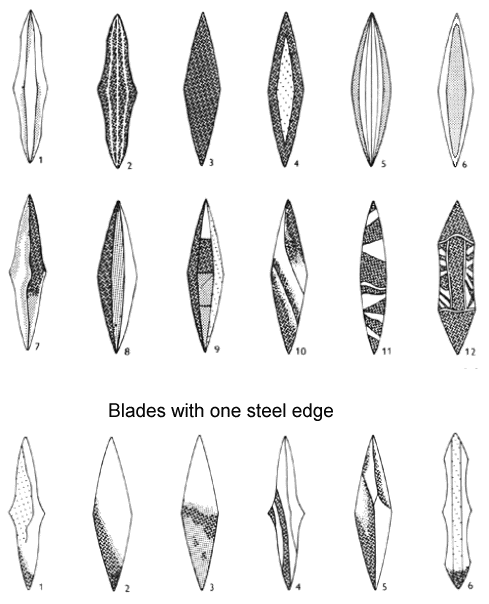
[ Download ]

| Luka Borscak wrote: |
| Nobody knows the sword that has the section number 12 in the picture? Anybody owns Pleiner's book? |
| Arne G. wrote: | ||
"Figure 17.12 Examination #94 CUVIO, near Varese, northern Italy. Iron sword. Musei Civic di Varese, no number indicated. The sections show that the blade has a central groove. Four specimens were cut out, three of them representing a semi-transverse section from one of the cutting edges, the fourth the hilt-tang. Longitudinal sections were also cut. Non-metallic inclusions. Slag inclusions and oxides are oriented along welding seams. Macrostructure (after etching). White lines (welds) divide the specimens into dark cutting edges with three panels in the centre: two outer flanks with sinuous dark and light pattern, and the dark core. Microstructure. In the dark areas pearlite prevails with varying carbon content (up to about 0.5%C), in the light zones ferrite or ferrite and pearlite. Hardness (1kg). Pearlite or pearlite-ferrite in the cutting edge 154-224HV, the central bar 190-210 HV, softer parts about 115 HV. Chemical analysis. Mn about 0.30% (high), P less than 0.005%. Interpretation (by A. Reggiori and E. Garino). The blade was composed and welded together from several bars of differing carbon content. The technology may be considered sophisticated. The properties of the artifact make it suitable for use as a weapon. There is no indication, however, of more rapid cooling of certain parts for regular hardening. Fig. 17.12. Reggiori and Garino 1955, 48-51, Figs 5-7 Comment. In spite of the absence of polishing of the faces, all sections reveal a composition typical of developed pattern welding, i.e. a blade with a central steel bar and pattern welded display flanks and welded on steel cutting edges. The profiles of the sections indicated the existence of a flat central channel which is, in itself, unusual for a La Tene sword. But the entire scheme corresponds perfectly with a Roman made spatha, which gives rise to a suspicion that the weapon may not be correctly classified among La Tene blades." |